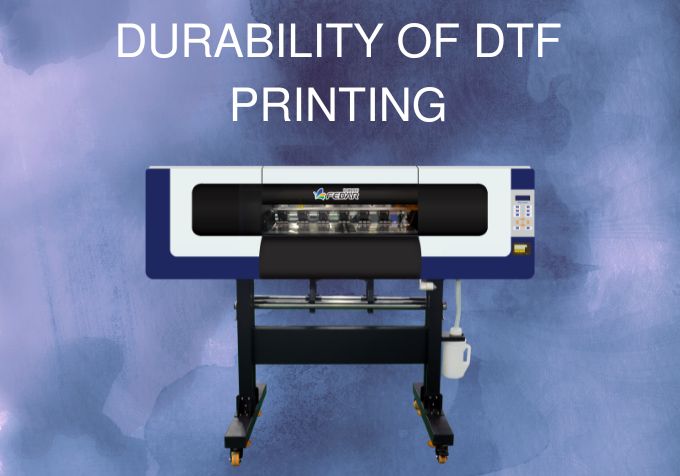17
Jan
Discover the durability of DTF printing, the factors influencing its washability, and why these prints outlast other printing methods.

DTF printing has changed the textile printing game due to its inherent qualities like color vibrancy, durability, and material versatility. As demand for high-quality, long-lasting prints increases, DTF is the way to go. But what makes DTF printing so durable and how does it compare to other printing methods? In this article, we’ll go over the factors that affect DTF washability, show you real-world case studies, and why DTF shirts stay vibrant and intact over time.
Inks: High-quality DTF inks are essential for vibrant and durable prints. The pigmented inks used in DTF printing are ideal for the film and fabric because they stick better and last longer. Cheap or low-quality inks will wash off or will be less bright after several washes.
Transfer Film: The type of transfer film used has a big impact on the durability of the print. Premium films have better ink retention and transfer so the design will stay intact even after multiple washes. The thickness and flexibility of the film also play a role in the print integrity over time.
Printer Calibration: Proper printer calibration ensures color accuracy and ink application. Misaligned printers will give you uneven prints that will wear out faster. Regular maintenance of the printer will also give you consistent and high-quality results.
Heat Press Settings: Temperature, pressure, and time settings during the heat transfer process are crucial. Overheating or under-pressing will weaken the bond between the ink and fabric, reducing durability.
DTF printing works best on fabrics that can withstand high heat and have a smooth surface for ink adhesion. Cotton and polyester blends are popular choices, but delicate fabrics can be done too with some extra care. Some specialized fabrics need pre-treatment before printing which will enhance the print durability.
Temperature: Should always be washed in lukewarm or cold water.
Detergent: Mild detergents without harsh chemicals are always best for DTF prints.
Drying: Air drying is better than machine drying because high heat can damage the print.
Case Study 1: Small Business
A California-based custom apparel business was getting overwhelmed with requests for personalized T-shirts. They turned to DTF to meet the demand. Using high-end inks and premium transfer films they were able to deliver products that lasted over 50 washes.
A local sports team needed uniforms with intricate designs and long-lasting prints. They chose DTF because it could produce sharp detailed designs. Despite being washed and worn outdoors the uniforms looked great all season long. DTF proved to be reliable and saved the team from reprints and costs.
The durability of DTF prints is due to:
DTF inks are designed to penetrate the fabric fibers, so the design is bonded into the fabric. Unlike surface prints, DTF designs are integrated into the fabric so they won’t fade. These inks are also UV resistant so they won’t fade in the sun.
The adhesive powder in the DTF process is key to durability. It’s the glue that holds the ink to the fabric, so the design will stay put even after multiple washes. Recent advancements in adhesive technology have made it even stronger and more flexible so it can work with more types of fabric.
DTF printing works with multiple fabric types so it’s a universal solution for many applications. Its ability to print on different materials is why it’s so popular. From activewear to formal wear, DTF prints are a reliable solution for long-term designs.
Screen printing has great color but doesn’t have the detail of DTF printing. Normal screen prints may crack or peel while DTF prints remain smooth and do not peel off. Screen printing is a process that needs several screens depending on the design, therefore, it is not economical for small production.
DTG printing has high-resolution designs but struggles with durability on some fabrics. DTF printing has both high res and longevity so it’s the choice of many businesses. DTG prints are limited to specific fabric types, DTF is more universal.
HTV cracks and peels easily on garments that get washed frequently. DTF printing’s strong adhesive properties keep the design vibrant and durable even under heavy use. HTV is also labor intensive, DTF is more streamlined.
DTF prints are getting more durable with technology advancements:
Eco-Friendly Inks: Manufacturers are coming out with inks that are durable and eco-friendly, for the eco-conscious consumers. These inks reduce environmental impact without sacrificing quality.
Improved Adhesive Powders: Recent advancements in adhesive chemistry improve the adhesion of ink to the fabric and make it long-lasting. These new powders are also more resistant to temperature and humidity than the previous ones.
Automated Process: Automation provides consistency and reduces errors. Modern printers with better sensors and software make the DTF process even better.
To extend DTF prints’ life, follow these tips:
Inside Out:
Washing garments inside out minimizes direct contact with the print and thus maintains the quality.
Wash Cycles:
Use gentle wash cycles to minimize wear and tear.
Chemicals:
Bleach and strong detergents can damage the print and fabric. Use mild detergents.
DTF printing is ideal for printing complex designs on a range of fabrics because of its many benefits. Its durability is due to advanced inks, strong adhesive, and precise application process. As the technology in this industry continues to develop, DTF printing will become even more durable and friendly for the environment. If you are a business person starting your business, or a customer who wants to buy clothes that will last long, then DTF printing is the best for you. It is possible to maintain the bright and long-lasting appearance of your DTF prints by learning from the best practices.

